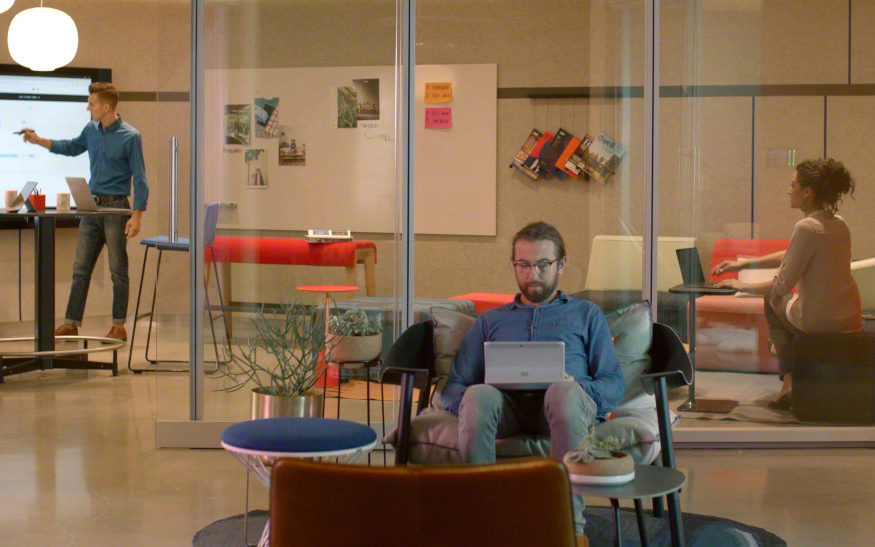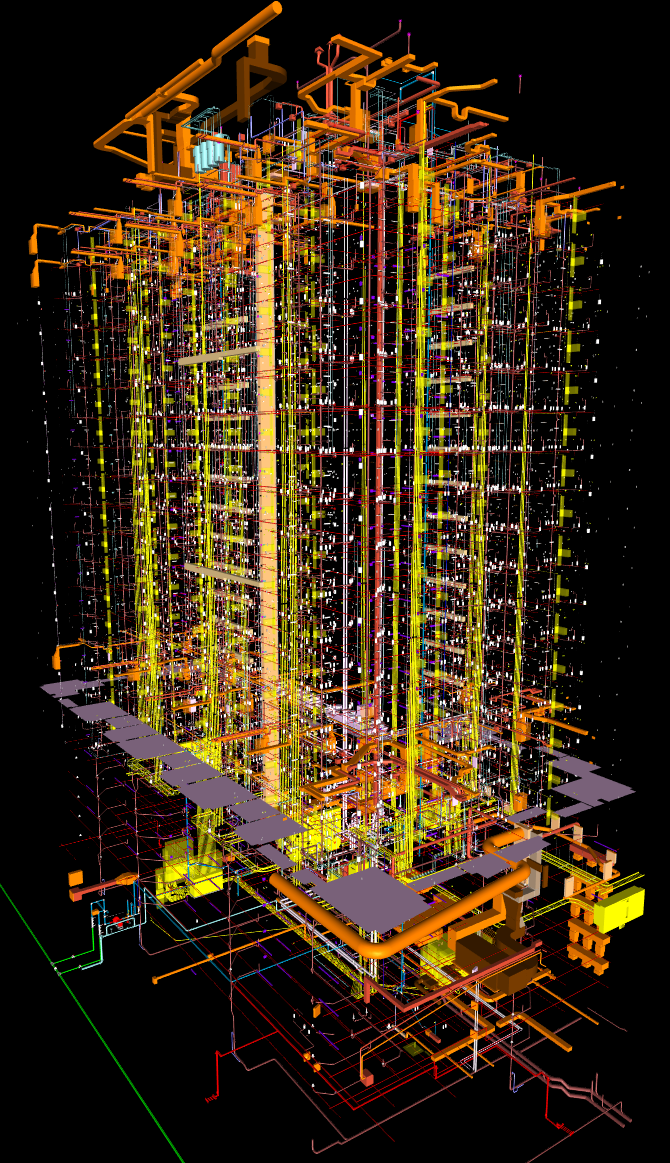
Danielle Fetzer is a Business Development Manager for our Wisconsin and Illinois region. She’s recently been reaching out to local business professionals to find out how they’re navigating these uncertain times and will be sharing these insights over the next few weeks. This is the second in her blog series; her first post discussed Work and Social Spaces in 2020.
Internet access is one of the most important modern resources that creates equity in opportunity for people
Austin Martin – Founder of Rhymes with Reason
Can you imagine working in the world today without technology? It has become a precious resource that is perceived as a necessity to complete most types of work. In the past few months, technology has enhanced the way we communicate, collaborate, and move business goals forward. The pandemic has forced the most technology-averse people to change behavior overnight in order to survive in today’s business climate.
In the very basic sense of a workplace, we go to a place that is designed to utilize the tools and see the people that make our organizations strong and more diverse. Technology then becomes the instrument that connects us from place to place, idea to idea and person to person. In this sense and in referring to the workplace, technology can be seen as a catalyst for innovation.
With the recent disruption to the workplace and with technology’s defining presence, I reached out to a few businesses paving the way with technology as a major focus. I was interested to get their thoughts on how technology will change as we continue to forge through 2020 and beyond. Technology is something we integrate daily in our planning and workspace design at Atmosphere, as our clients continue to ask for more. Also, I like to seek out interesting, unique content, so what better way to learn than from leaders at two fantastic local companies?
|
Brad Hollister is CEO of SwanLeap. “Powered by Artificial Intelligence, SwanLeap disrupts and realigns supply chain processes with our transportation knowledge and technology expertise.” |
Erik Lindwall is Director of Information Technology at C.D. Smith Construction, a Wisconsin-based commercial construction firm headquartered in Fond du Lac, with offices in Milwaukee and Madison. |

Technology is a large portion of your business. Can you explain how your organization utilizes technology?
Brad Hollister: We’re a tech company. We see tech as an opportunity to leverage processes through automation. One person can do the work of ten with good technology and collaboration. Think back to the office setting of the 1980s, there used to be messengers relaying information to one another. Now we have Slack and email. You can even do Zoom calls in real time, from 50,000 miles away.
Erik Lindwall: C.D. Smith assists clients in managing the construction process of commercial buildings and we feel that technology offers a unique client experience. All of our superintendents and project managers have iPads, phones and laptops that they utilize on a jobsite and in the office, to achieve a successful outcome and maintain a level of urgency. In the wake of the pandemic our teams were utilizing Microsoft Teams on the jobsite to better illustrate what was happening. There is a saying that “a picture is worth a thousand words.” A video goes well beyond that.
Other than my position, C.D. Smith also has a Director of Virtual Construction. Augmented reality is being used in the construction industry to allow the people in the field to quickly see inside walls and spaces in real time while comparing the space from photos captured previously.
What space allocations should be thought of to have a successful technology experience?
Brad Hollister: Collaboration spaces! We have a lot of meeting rooms – sort of the open office plan – that fuels our collaboration. This is especially important for a tech company that relies on multiple developer teams to create software.
Erik Lindwall: Specific to our new headquarters in Fond du Lac, Wisconsin: it was built and designed for focus rooms to get away from the chaos. We need spaces for spreadsheets and plans to be spread out on paper, but also with technology. We also built a 65-person lecture hall that is used for video conferencing, team and consultant meetings. This lecture hall also has a mic system to allow for ease in hearing anyone at any square foot of the space. Lastly, we have a room dedicated to Virtual Reality (VR), allowing our clients to visualize their facility before it is built.
Has your company had to modify any of their technology processes because of working from home? What has your organization learned over the past few months?
Brad Hollister: SwanLeap was well prepared for all of this because we already depend on technology for collaboration. So thankfully, this was not as big of a change for us.
Largely we have seen this huge shift in global culture. Suddenly we have elderly people learning technology in order to stay in touch with people they love. Everyone has had to adjust quickly on a daily basis, which has led to highs/lows and lack of consistency within business. With that lack of consistency, our clients have been reaching out for more visibility into their logistics and supply chains.
Erik Lindwall: When the pandemic began and our office needed to work from home, I thankfully kept a lot of old monitors (30-60) we used at previous buildings. So that was covered! And we converted to Cloud VPN two years ago, which helped as well.
I learned specifically that I miss my standing height desk! Also, a lot of our team lives in rural areas so we learned that Wireless or standard DSL are not always strong enough to work from home. We also learned how to communicate in a different way. Through Microsoft Teams, we leave chats up all day which helps with camaraderie and creates a fluid environment of instant communication.
As we move forward in 2020, what advancements do you foresee technology taking?
Brad Hollister: I think AI will become more prominent as its role is better understood in various spaces. The most important thing to consider is that AI is just beginning its journey. People are dreaming about the possibilities of AI, but it is going to take years of work and revision to get to the future possibilities. There are images of AI-powered robots replacing humans. That simply isn’t feasible without years of revision. The role of AI is changing as people accept virtual assistants and smart technology, so that AI drives intelligent automation that assists humans in making decisions. We’re starting to realize the benefits from early process automation that only AI can provide and it’s starting to paint a clear picture of what AI is capable of.
Erik Lindwall: Something we are already implementing at C.D. Smith is facial recognition scanners in all entryways to the buildings. This is a contactless technology that will take your temperature and notify someone if you are or are not allowed in the building. We feel this is better than asking one of our teammates to administer a temperature check.
Personally, I think we will see technology change significantly over the next six months. If we think about how different generations use technology – Boomers are traditionally known for using email that takes time and Gen Xers are known for utilizing editable documents that can be changed in a minute. How do you have one platform that captures all of this and can sync with our executive plans? And how do we keep continuing education going for this to be successful?
AI is largely talked about, throughout many different industries. What are your thoughts on this being a useful tool?
Brad Hollister: AI is an assistant that helps you make decisions. The benefit of AI is automation of consistent process reinforcement. AI can automate human decision-making on an infinite scale and can reinforce business intelligence. Using AI helps decision-making because it is predictable and helps mitigate risk of variables.
Erik Lindwall: AI is only in the baby stages of creation. I can see AI specifically affecting the construction industry with assessing job safety, estimating, procurement and scheduling. But on a larger scale, companies are competing for business and the profit margins are getting smaller and smaller. I foresee AI assisting with that in making companies more competitive.
I want to personally thank Brad Hollister and Erik Lindwall for contributing to this knowledge share session. It is insight like theirs that helps us at Atmosphere better understand the clients we serve every day. Interested in reading more? Look for my blog 3.0 to be out soon!

Danielle Fetzer
Business Development Manager
414.322.5671
danielle.fetzer@atmosphereci.com


